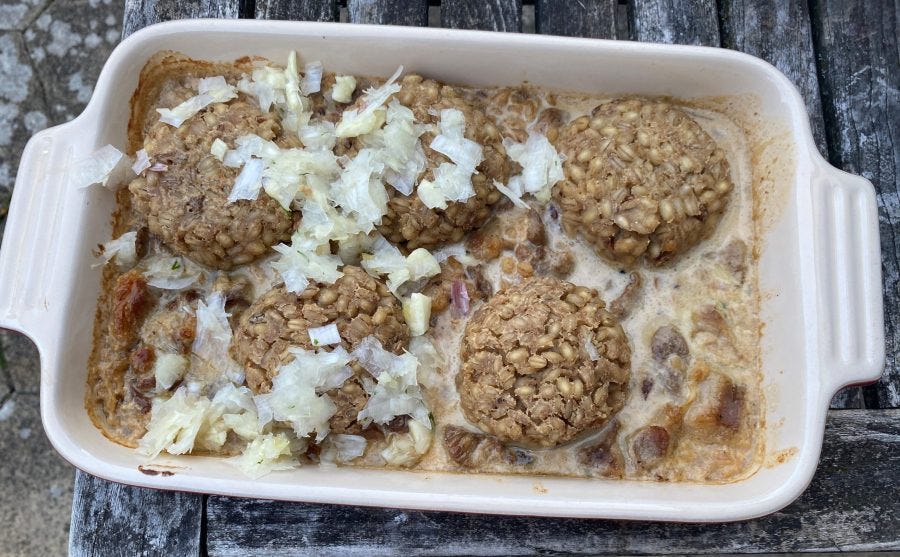Welcome to Thursday Things! A special welcome to the latest batch of Happy Subscribers. I hope you will enjoy this weekly ramble through the quirky and intriguing corners of the the online (and sometimes offline) world. This week we go subatomic, catch up with the great Gatsby, and delve into some savory food-based history. Let’s go!
“Honestly, he’s not that great.” Photo by Marvin Meyer on Unsplash
Due to the strange complexities of copyright law, which I won’t go into right now, the entry of old copyrighted works into the public domain — meaning they become free for anyone to use any way they wish — was on pause for a couple of decades. In recent years, the public domain has reopened and each January 1 many classic books, films, and other creative works join the cultural commons. Along, of course, with many, many much more obscure works.
In 2021, works first published in 1925 enter the public domain — including The Great Gatsby, by F. Scott Fitzgerald. Can Gatsby: Zombie Fighter be far behind? Probably. But at least one author is thinking ahead and has a more serious Gatsby prequel in the works: The Great Gatsby prequel set for release days after copyright expires
Nick Carraway, last seen at the end of The Great Gatsby contemplating the futility of trying to move beyond our past, is set to reveal a little more of his own, with author Michael Farris Smith announcing his prequel to F Scott Fitzgerald’s classic novel.
US copyright in The Great Gatsby, which is generally regarded as one of the best novels ever written, expires on 1 January 2021, meaning that the work enters the public domain and can be freely adapted for the first time. Farris Smith’s prequel, Nick, will be published four days later, on 5 January, in the US, by Little, Brown; and on 25 February in the UK by No Exit Press.
I read Gatsby in high school, and probably will reread it at some point. Doubt I’ll run out to buy this prequel. Unless they add zombies.
But I am always excited to see what is coming into the public domain and what interesting and creative things authors, musicians, and other artists do with such material. (Full disclosure: I wrote a sequel to Moby Dick in middle school. Let’s just say the white whale is back … for revenge!)
Is the universe alive? As usual subatomic particles make my head hurt. And they keep finding new ones. Just when I think I have a handle on quarks, along come skyrmions. A what now? “A skyrmion is considered a quasiparticle because it acts like a subatomic particle in many ways, but doesn’t have any mass.” Ah. Well, it’s all clear now. And one bizarre thing about these skyrmions is that they can can reproduce by splitting in two, much like a biological cell.
Skyrmion structures can grow through an additive process, in which their crystalline pattern expands outward as new skyrmions are formed, according to the study.
But it’s actually preferred — energetically favorable at the nanoscale level — for them to split in two and self-repair, an unprecedented parallel between particle physics and cellular biology.
So is there some quasiparticle equivalent to DNA? Can subatomic particles evolve into smarter, faster, stronger particles? Has that already happened?
You can read more about skyrmions here.
The lure of delicious sweet potatoes — Study shows ancient contact between Polynesian and South American peoples
New genetic research shows that there was mingling between ancient native peoples from Polynesia and South America, revealing a single episode of interbreeding roughly 800 years ago after an epic transoceanic journey.
The question of such contact – long hypothesized in part based on the enduring presence in Polynesia of a staple food in the form of the sweet potato that originated in South and Central America – had been keenly debated among scientists.
This story is a nice crossover of history and genetics, though the DNA evidence is only confirming what was fairly obvious. If sweet potatoes are known to originate in South America, yet were found throughout Polynesia, then somebody visited somebody. And the first guess has to be the boat-building Polynesians. I’m a sucker for any story that involves uncovering hidden connections in history. And also sweet potatoes.
4,000 years is a long time to wait, but Mesopotamian cuisine finally gets its moment! Cook Like an Ancient Mesopotamian With the World’s Oldest Recipes
HISTORIAN JEAN BOTTÉRO CONCLUDED HIS 2001 article, “The Oldest Cuisine in the World: Cooking in Mesopotamia,” with an insult of sorts. “I would not advise trying to incorporate their culinary tradition, just as it stands, into our own,” he wrote, speculating that a modern eater would not enjoy the garlic-heavy, salt-light dishes that people ate nearly 4,000 years ago.
But ever since, chefs around the globe have attempted Mesopotamian recipes, the oldest on record, in their home kitchens. Nawal Nasrallah, an Iraqi scholar and and cookbook author, has written about adapting the ancient recipes for modern kitchens. Nearly a decade ago, Laura Kelley, founder of the blog The Silk Road Gourmet, organized an ancient Mesopotamian cooking challenge. More recently, an interdisciplinary team from Yale and Harvard whipped up a Mesopotamian feast in 2018. All three endeavors had the same source material: a set of four ancient clay tablets in the Yale Babylonian collection.
When Thursday Things last visited Yale in June, it was to marvel at their 1648 Dutch water bonds that still pay interest. Now it’s 4,000-year-old clay tablet cookbooks. I thought I was a hoarder, but Yale really puts us all to shame in that department.
The Mesopotamian menu includes meat broth and for dessert “Mesoptomian pastry chefs crafted recipes for qullupu, a sweet date-filled cookie, and mersu, a date and pistachio candy.” Recipes for making your own modern approximation of the broth and mersu are at the link. If any Happy Subscribers give Mesopotamian cooking a try, let us know how it is!
You can find all the ancient recipes in the book Ancient Mesopotamia Speaks: Highlights of the Yale Babylonian Collection. And in this article you can see pictures of some of these dishes prepared by Cambridge professor Bill Sutherland.
Here is the lamb stew recipe:

Instructions seem clear enough. Getting Persian shallot might be tricky. Source: Open Culture
And here is the finished dish:

Lamb stew the ancient way! Looks good to me! Source: Open Culture
Again — if you give this a try, let Thursday Things know how it turns out!
Actually, I’m kind of hungry now. Time for lunch.
Thank you for reading Thursday Things! See you next Thursday, same Things time, same Things channel!



